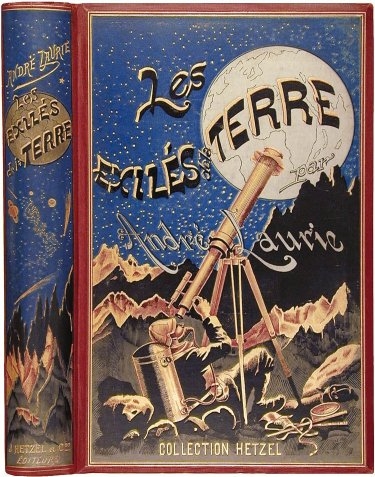May 17 - July 29, 2000
The Art of Publishers' Bookbindings, 1815-1915
Curated by Ellen K. Morris & Edward S. Levin
 In May of 2000 the Grolier Club will mount the most comprehensive exhibition ever produced of nineteenth-century publishers' bookbindings, showcasing the imaginative design, rich materials, and skilled artistry of these 'mass-produced' objects. Two hundred and fifty examples from America, England and Europe have been chosen to highlight the period bounded by Waterloo and World War I, during which books became elaborate vehicles for the visual arts and technical innovation.
In May of 2000 the Grolier Club will mount the most comprehensive exhibition ever produced of nineteenth-century publishers' bookbindings, showcasing the imaginative design, rich materials, and skilled artistry of these 'mass-produced' objects. Two hundred and fifty examples from America, England and Europe have been chosen to highlight the period bounded by Waterloo and World War I, during which books became elaborate vehicles for the visual arts and technical innovation.
The nineteenth century brought social and economic changes which were directly reflected in a vastly changed market for books. With the Industrial Revolution and growth of mass-marketing in Europe and the United States, especially during the second and third quarters of the century, books were produced in increasingly greater numbers for wider popular consumption by increasingly literate industrial nations. Publishers met these changing expectations through the creation of ready-made, 'fully packaged' books: pre-bound and embellished with new and different materials and decorative techniques. Accordingly, it was during this period that books became important as objects of design for a mass audience.
Bindings from all industrialized countries have been included, making it possible to see stylistic and technical interchanges, compare national differences, and assess the varied roles of publishers and artists in nineteenth-century book design.
Materials and techniques employed in bookbinding were extensive and diverse. Early experiments with materials included printed paper boards, silk, and, what would prove to be the most practical, cotton cloth. Indeed, almost from the beginning, cloth was the preferred material for casing popular books. Leather bindings, however, continued to be produced, and, with a greatly expanding market, the use of leather was explored as imaginatively as cloth.
Both cloth and leather were stamped (in blind, in gold, in silver and in color), molded, embossed, dyed, patterned, onlaid, and inlaid in various ways. Other methods of executing artistic designs upon the binding of a book in altogether new and imaginative forms were undertaken. Paper bindings, as well as bindings executed in other often highly idiosyncratic materials, utilizing numerous machine techniques, appeared on the scene.
The exhibition, curated by Ellen K. Morris and Edward S. Levin, and drawn from their private collection, is organized in three sections. The first serves as a chronological survey of primarily American and English bindings, and provides a broad overview of the historic trends in bookbinding design. The second section focuses on materials, colors and production techniques, and the third section illustrates the staggering range of special examples and designs represented in the collection.
Viewed as a whole, it enables both bibliophiles and the public to understand and appreciate nineteenth century publishers' bookbindings as a coherent genre, significant in the history of the applied arts.
A catalogue, with full-color illustrations and descriptions of all 254 books in the exhibition, is available. Published by William Dailey Rare Books Limited, it includes a foreword by Ruari McLean, an afterword by Sue Allen, and an introduction by Morris and Levin.